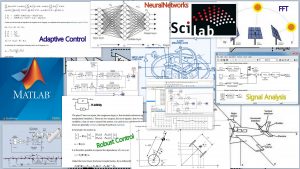 I started my career in academia teaching and researching Control Systems and their implementation in real time. My education from college to PhD has been focused on Control Systems. My degree projects have been on Stochastic and Direct Adaptive Control and Neural Networks. From that time, I have some of my publications listed here for you to download.
I started my career in academia teaching and researching Control Systems and their implementation in real time. My education from college to PhD has been focused on Control Systems. My degree projects have been on Stochastic and Direct Adaptive Control and Neural Networks. From that time, I have some of my publications listed here for you to download.
RESUMÉ
To receive a copy of my resumé, please use the Contact Me form to request it.
ADJUSTABLE NEURAL NETWORK CONTROLLER: APPLICATIONS TO A LARGE SEGMENTED REFLECTOR
 A neural network controller (NNC) whose parameters are adjusted online is presented to control a class of multivariable linear systems. The plant to be controlled is assumed to be square (p inputs, p outputs) and almost strictly positive real (ASPR). The NNC is applied to a linear model of a large segmented space reflector and simulation results are presented. The ASPR condition is a strong condition, in general, but for the specific application of interest, i.e. control of flexible structures, the ASPR condition can be satisfied by an appropriate combination of the output variables (positions and velocities). As compared to other adaptive NNC reported in the literature, the proposed NNC is simpler and more suitable for real time applications.
A neural network controller (NNC) whose parameters are adjusted online is presented to control a class of multivariable linear systems. The plant to be controlled is assumed to be square (p inputs, p outputs) and almost strictly positive real (ASPR). The NNC is applied to a linear model of a large segmented space reflector and simulation results are presented. The ASPR condition is a strong condition, in general, but for the specific application of interest, i.e. control of flexible structures, the ASPR condition can be satisfied by an appropriate combination of the output variables (positions and velocities). As compared to other adaptive NNC reported in the literature, the proposed NNC is simpler and more suitable for real time applications.
1997 American Control Conference, Vol I, pp. 227-231, Albuquerque, New Mexico, June 1997
THE USE OF DECENTRALIZED CONTROL IN THE DESIGN OF A LARGE SEGMENTED SPACE REFLECTOR
 ( NASA site ) The 3-dimensional model for a segmented reflector telescope is developed using finite element techniques. The structure is decomposed into six subsystems. System control design using neural networks is performed. Performance evaluation is demonstrated via simulation using PRO-MATLAB and SIMULINK.
( NASA site ) The 3-dimensional model for a segmented reflector telescope is developed using finite element techniques. The structure is decomposed into six subsystems. System control design using neural networks is performed. Performance evaluation is demonstrated via simulation using PRO-MATLAB and SIMULINK.
NASA URC Technical Conference, pp. 645-653. Albuquerque, NM. February, 1997
REPRESENTATION OF FIRST ORDER DYNAMICAL SYSTEMS USING NEURAL NETWORK
![]() The approximation of dynamical systems (DSs) using neural networks (NNs) is considered in this paper in a broader sense than the mere trajectory approximation for finite time. The object of this study is to try to determine the capabilities of NNs to reproduce structural properties of DSs in order to achieve approximation for all trajectories that remain in a closed region of the state space as t tends to infinity. This is a new approach to approximating DSs using NNs, which the authors call the representation of DSs rather than an approximation of trajectories. The problem so stated is under current research, and the preliminary results concerning first order dynamical systems are presented here.
The approximation of dynamical systems (DSs) using neural networks (NNs) is considered in this paper in a broader sense than the mere trajectory approximation for finite time. The object of this study is to try to determine the capabilities of NNs to reproduce structural properties of DSs in order to achieve approximation for all trajectories that remain in a closed region of the state space as t tends to infinity. This is a new approach to approximating DSs using NNs, which the authors call the representation of DSs rather than an approximation of trajectories. The problem so stated is under current research, and the preliminary results concerning first order dynamical systems are presented here.
ICNN.1995. Conference: Neural Networks, 1995. Proceedings. IEEE International Conference on, Volume: 1, pp. 496-501
DUAL CONTROLLER BY CORRECTIONS VECTOR AND ITS EXTENSION TO SYSTEMS WITH COLOURED NOISE
In this work a new sub-optimal dual control strategy is proposed and compared with two previously known strategies of dual control. The simulations have stressed the aspect of the transient behavior of the diverse strategies. This is done in order to verify the following hypothesis: If dual control weighs both the control task and the the identification task, then this type of control may eventually improve the transient nature of the estimation and control.
Proceedings of the IEE Control 85, Vol II, pp. 692-696, Cambridge, England, 1985
A REAL TIME APPLICATION OF THE DUAL CONTROLLER BY CORRECTIONS VECTOR
The dual controller by corrections vector (Luzardo and Padilla) is a sub-optimal dual control strategy. This controller has shown its efficiency in computer simulations. The efficiency is measured through the transient response of the controlled system. In the transient response, the must provide the control signals to follow the reference and to assure a good estimation of the parameters. The algorithm of the dual controller by corrections vector presents the disadvantage of requiring a search procedure to find the roots of a fifth order polynomial. This drawback may eventually be a limitation in a real time application of the controller. This paper investigates such an application.
Proceedings of the IEE Control 85, Vol II, pp. 614-619, Cambridge, England, 1985